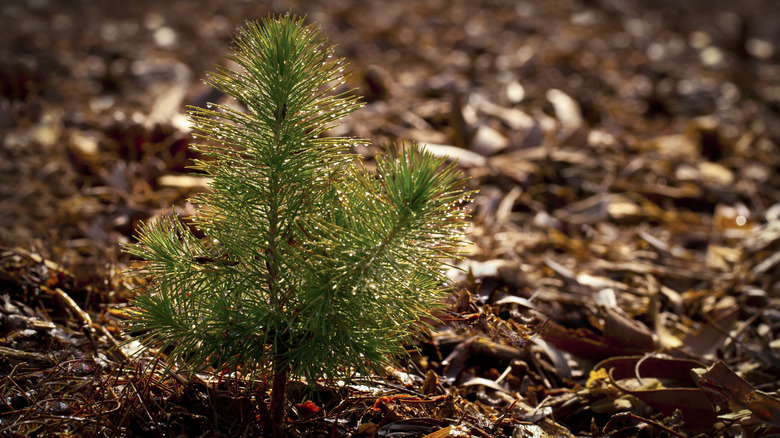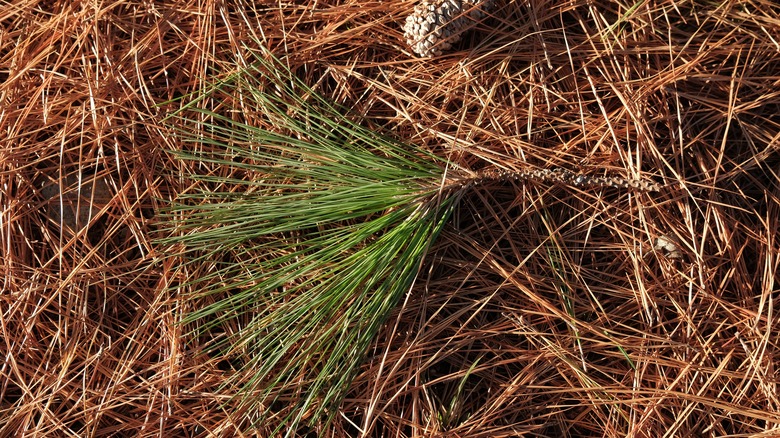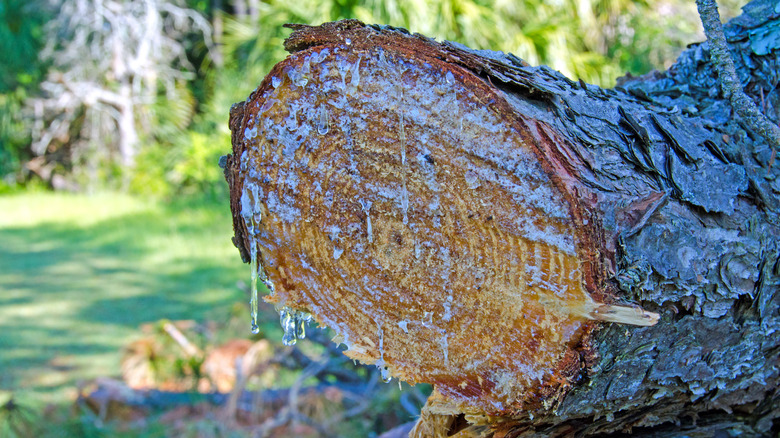This Fast-Growing Pine Tree Has Some Messy Downsides To Consider Before Planting
Native to the central and eastern United States and Canada, the stunning eastern white pine (Pinus strobus) is a fast-growing tree, easily reaching up to 80 feet tall and 40 feet wide. You won't see most of the fast growth until after the tree is eight to 10 years old — then, it can grow as much as 54 inches in just one year. Although a beautiful, hardy, and easy to grow tree, it doesn't come without its cons. Even if you live somewhere with a large enough yard, you may want to consider the potential litter problems of the eastern white pine, which include needle drop and bleeding sap.
Eastern white pine trees are evergreen, meaning they stay green year-round. However, evergreen trees drop older pine needles annually as part of their life cycle. If you see orange or yellow pine needles, this could mean they are at the end of their lifespan. Not only that, but the tree also produces a sticky sap that's hard to clean thanks to its high resin content. Before you jump to buy an eastern white pine tree seedling, learn more below about the tree's messy downsides and how it can make your life a little harder.
Falling pine needles
There are two main downsides to consider before planting eastern white pine trees in your yard: the annual pine needle drop and tree sap. It's completely normal for evergreen pine trees to "shed" their needles. The needle drop isn't just messy, but can look alarming. For a short while around once a year, the bulk of an eastern white pine tree's inner needles will turn yellow, which can make the tree look sick. This is just part of the tree's life cycle as the older inner pine needles lose their green color and fall to the ground.
You'll also need to clean up the pine needles that fall from your eastern white pine tree — when they're on the ground, they can be dangerous in some climates. You may want to think twice before using fallen pine needles as mulch since pine needles act as dry fuel. If you live in a wildfire-prone area, you should rake the pine needles up and remove them from your yard, as they can worsen any fires that could come your way.
Dripping eastern white pine tree sap
Something else to consider before planting the eastern white pine tree? The sticky substance it produces. Pine sap is normal, occurring year-round, although it is more prominent during spring. It can ooze from its bark, and while harmless, can get stuck to just about anything. The syrupy liquid doesn't necessarily indicate there is a problem with your tree, but it can be annoying to deal with as it hardens quickly and is difficult to remove. This is especially frustrating if it gets on your clothing, car, or patio , although when it comes to your car, you can use WD-40 to safely clean up the tree sap. It's unlikely sap will drip onto your clothes, but you can accidentally touch and smear it. It can even get on your pets if they run around in your yard and rub against it.
Another time sap is more noticeable is when the tree is injured. Even simple routine pruning can cause bleeding. If the tree has damage from bugs like borer insects, it'll ooze sap. It drips down as a liquid and crystallizes, drying and creating white streaks. Excessive bleeding could be a sign of a bigger problem, especially if you notice any dead bark.
If you still want to plant this tree and don't mind the mess, you'll need to pick a good spot. Eastern white pine trees thrive in full sun and partial shade in USDA hardiness zones 3 through 7, and grow in both alkaline and acidic soil.


